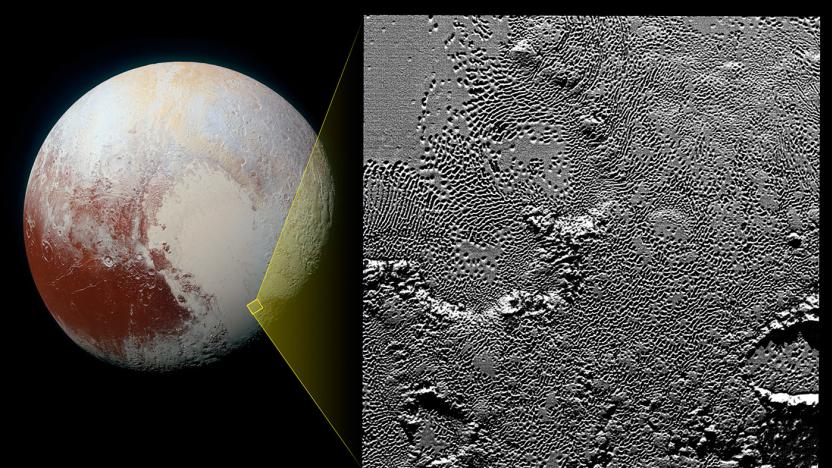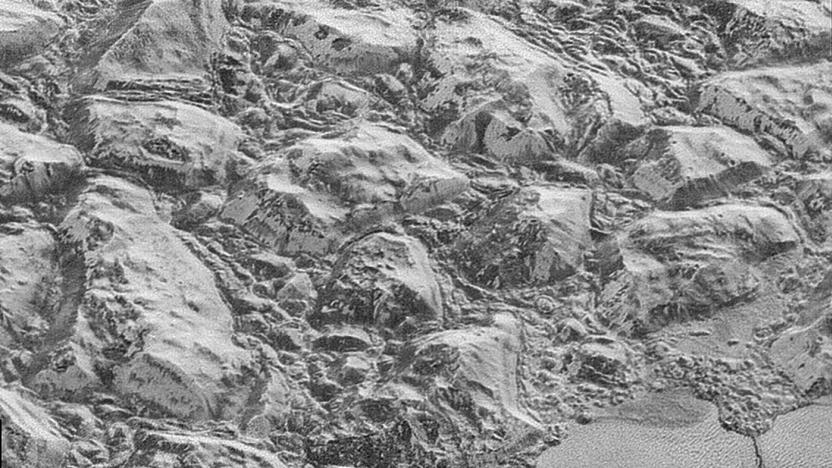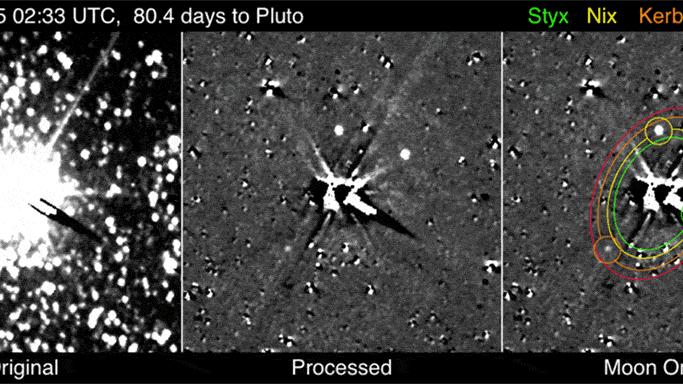timeline16plutomedia
Latest

USPS' 2016 stamps celebrate Pluto's exploration
The US Postal Service now has an answer to its 1991 "Not Yet Explored" Pluto stamp, the same one the New Horizons team affixed to their probe before it started its journey to the dwarf planet. These new stamps for 2016 feature an artist render of the history-making spacecraft, as well as the most popular image it took of Pluto. The composite photo, which clearly shows Pluto's heart-shaped region, was captured by the probe's Long Range Reconnaissance Imager (LORRI) during its closest approach.

Pluto gets rainbow-hued in NASA's latest images
Pluto may have been imaged six ways from Sunday, but it's clear that the New Horizons probe still has a few surprises up its sleeve. NASA has posted both a photo and a video showing how the spacecraft can produce vibrant colors from the seemingly drab-looking dwarf planet. The key is New Horizons' infrared spectrometer. Its linearly-varying filter produces a stained glass window effect as it looks for reflected chemicals, like in the clip you see below -- the dark bands come when Pluto's methane ice absorbs those materials. And when researchers plug the results into visible color channels, the result is the almost festive mix of red and green (with hints of blue) that you see above.

Watch Pluto's mesmerizing space weather
Ever wondered what the cosmic weather is like, especially around more distant worlds? NASA's happy to help. It recently published a simulation of the Solar System's weather (specifically the Sun's flares, winds and other behaviors) around the time New Horizons swung by Pluto. The color-coded imagery, which reflects the density, pressure and temperature of outgoing plasma, is more than a little hypnotic -- the plasma slowly spirals out, with coronal mass ejections creating shockwaves (the blue you see above) that travel to the farthest reaches of the system.

NASA releases an even closer look at Pluto's heart
Now that you're better acquainted with Pluto's mountains and ice fields, it's time to examine its heart. We're talking about the dwarf planet's heart-shaped region called Tombaugh Regio, of course, which is prominently displayed in many of its most famous images. During New Horizons' closest flyby in July, the probe's Long Range Reconnaissance Imager (LORRI) zoomed in on the area and took photos within 9,550 miles of its surface.

NASA shows the sharpest ever close-up photos of Pluto
I can practically hear you groan -- more Pluto photos? Well, these are kind of special: they're the sharpest pictures the New Horizons probe took during its closest flyby in July, and NASA believes these may be the best snapshots of the dwarf planet we'll see for decades to come. These series of images captured by the spacecraft's Long Range Reconnaissance Imager (LORRI) from 10,000 miles away have a resolution of 250 to 280 feet per pixel. That makes them, according to the agency, six times better than the global Pluto map it released earlier. When stitched together, those photos form a 50-mile strip full of craters, ice fields and mountains that show up so clearly, it's as if they merely display one of the polar regions filmed from aboard a helicopter.

NASA finds that Pluto has blue skies and surface water ice
Move over Mars, NASA's just confirmed that Pluto, everybody's favorite Kuiper belt object/celestial punching bag, not only has expansive fields of water ice on its surface but blue skies as well. Granted Pluto has neither the thick atmosphere nor global oceans that the Earth does, so the "blue sky" NASA's New Horizon's team spotted last week is actually more of a haze. And, technically, the haze particles themselves would likely appear either red or grey to the naked eye. However, the fact that they appear blue from this distance tells NASA a lot.

The Big Picture: A colorful and dazzling view of Pluto
While NASA has already shown us Pluto's best images yet, the administration is anything but done blowing our minds. What you see above is an enhanced high-resolution color view of Pluto, created with a combination of blue, red and infrared images. NASA says this photo, taken by New Horizons spacecraft, highlights Pluto's diverse landforms and shows us its complex geological and climatological story -- as much as scientists have been able to figure out, anyway. Over the past few months, NASA's shared many things related to Pluto, including a closer look at its desolate surface and icy mountain range.

NASA's Pluto probe starts a year-long data upload
NASA's New Horizons probe didn't swing by Pluto just to snap a few photos and run off -- it collected a ton of extra data that hasn't seen the light of day. Well, it's finally sending that data back to Earth... very, very slowly. The spacecraft has started an upload of "tens of gigabits" of information that, at a pokey 1KB to 4KB per second transfer rate, won't finish until fall 2016. You'll get raw photos from New Horizons every Friday, but it could take a long while before astronomers know exactly what they have on their hands. It may be worth the wait, mind you. If NASA's initial burst of Pluto data was an eye-opener, you can imagine what a year's worth of info might bring.

NASA's latest Pluto discoveries include hazy skies and flowing ice
Ready for another dose of Pluto news? Of course you are! During an event today, NASA shared its latest discoveries in regards to the icy dwarf planet. First, detailed imagery from New Horizon's Long-Range Reconnaissance Imager (LORRI) shows "geologic activity" on the surface that includes flowing ice on a plain known as Sputnik Planum. That area lies in the western part of that massive heart-shaped region you've likely noticed in photos. NASA says the ice there flowed, and may still be flowing now, in a way that resembles the movement of glaciers on Earth. In the southern portion of Sputnik Planum, researchers discovered a range of icy mountains that rise about a mile and can be compared to the Appalachian Mountains here in the States. In fact, the peaks have been informally named Hillary Montes and are located near another range named Norgay Montes. The names are in honor of Sir Edmund Hillary and Tenzing Norgay -- explorers who first reached the summit of Mount Everest in the 1950s.

NASA gives you a flyover view of Pluto's icy mountains
Hey NASA, stop blowing our minds, okay? Actually, no, please continue.

Neil deGrasse Tyson and friends gush over today's Pluto flyby
At around 7:50AM Eastern this morning, NASA's New Horizons probe reached its closest point to Pluto, around 7,750 miles away, where it unleashed its full array of equipment to give us our best look yet at the dwarf planet. It's the culmination of a nine-year journey across more than 3 billion miles -- and the scary thing is we won't even know until tonight if it succeeded. To celebrate the occasion, we joined Neil deGrasse Tyson, his colleagues and a theater full of science geeks at the American Natural History Museum to explore what the New Horizons mission really means. You can check out the full session, as well as some highlights from the event, below.

The Big Picture: NASA unveils best Pluto image yet (updated)
Anxious to see the closest shot of Pluto ever? NASA is set to release high res photos soon, but in the meantime, the space agency has posted a "love note back to Earth" with a low-res Instagram image. That marks the first time the agency has given a social network first dibs on a major image, according to Wired. The image itself was snapped by the New Horizon probe 16 hours before its closest approach, some 476,000 miles away. NASA said it will release higher resolution versions of the image later tonight and discuss them in a briefing at 8AM briefing (EDT) on NASA Television. We'll bring you all the details of that a bit later on, but in the meantime, enjoy the best photo ever taken of our solar system's bastard stepchild planet.

Pluto's latest photo shows geologic features
As the New Horizons probe gets closer to Pluto, the pictures its cameras capture also get clearer. Take for example the black-and-white image above: it's no longer just a blob or an extremely blurry circle. Sure, it's not as sharp as we'd all like it to be (pssst, you'll only have to wait a few more days for those pics), but its details are pronounced enough to show the dwarf planet's geology. What you can see here is the side of Pluto that always faces its largest moon, Charon. It was taken on July 9th by the spacecraft's Long Range Reconnaissance Imager (LORRI) from a distance of 3.3 million miles.

430,000 names are hurtling towards Pluto right now
Do you remember what you were doing on the internet back in 2005? No, of course you don't--modern smartphones didn't exist yet, YouTube was just starting out and Facebook was still just an "online college yearbook." You might have stumbled upon a NASA webpage looking for folks to be a part of the "first mission to the last planet." Participants had their name burned onto a CD and launched into space with the New Horizons spacecraft. Can't remember if your moniker is among the stars? There's an easy way to find out.

NASA's latest Pluto images actually show a planet
At last, NASA's New Horizons spacecraft is sending back images of Pluto that look (slightly) better than brown blobs or pixel art. The probe has delivered a new batch of images from between 7.8 million to 9.2 million miles away, or close enough that the dwarf planet is starting to reveal some meaningful detail. There's still no explanation for those giant spots, but it's evident that there's a "continuous swath" of dark ground near the equator. And if you'd like pictures that are better than fuzzy, you might not have to hold out for too much longer. New Horizons should be considerably closer when it recovers from its recent glitch, and the expected July 14th flyby should produce a ton of extra detail. [Image credits: NASA/JHUAPL/SWRI]

NASA mission sends back fuzzy, color 'movies' of Pluto
Sure, Pluto doesn't have full-fledged planetary status anymore, but we're still excited to get some pictures from the edge of the Solar System. The New Horizons spacecraft is carrying a "Multicolor Visible Imaging Camera" that takes stills in blue, red, and near-infrared, then puts them together for a color picture. It took a series of pictures between May 29th and June 3rd that show the dwarf planet and its largest moon, Charon revolving around their shared center of gravity. The mission will make its closest approach to Pluto on July 14th when it gets about 7,800 miles above the surface (shown above in an artist rendering). You can check out the low-res animation after the break, and mark your calendar for the better look that's just 24 days away.

NASA probe snaps Pluto's smallest moons for the first time
Getting kicked out of the major planet club always seemed a bit unfair to Pluto, considering that it has four more moons than Earth. On the other hand, two of those, Styx and Kerberos, are so small that we only found out about them a few years ago. NASA's New Horizons probe has just taken its first snapshots of those new satellites, something of a miracle considering it was 55 million miles away and Styx is only 4 to 13 miles across. It required 10 second exposures from the probe's sensitive Long Range Reconnaissance Imager (LORRI) and copious image processing to reduce background glare, resulting in the animation above.

Why did Pluto lose its planet status? Because it never mattered enough
It's kind of hard to accept, Pluto has always been our favorite underdog, but the truth is that the Solar System's ninth planet was never really significant enough to earn that designation. Such is the coldly logical reason given for its removal from the planetary annals by a man who had a lot to do with its demise. Caltech astronomer Mike Brown discovered Eris, what he'd hoped was the tenth planet, back in 2005, but its extreme distance from the Sun and diminutive (by planetary standards) dimensions disqualified it from consideration. Unfortunately, its discovery is what doomed Pluto to be downgraded to a "dwarf planet," though Mike's not shedding too many tears over it. In fact, he's gone and written a book about the whole thing, the smug planet destroyer that he is. You don't have to buy it to learn more, however, as the source link has an interview with Mike all ready and waiting.









